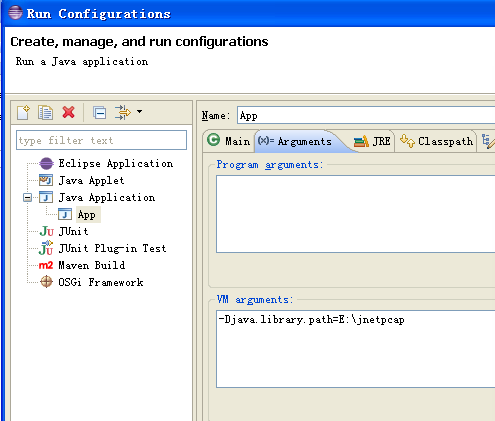我们经常使用Httpwatch查看HTTP的传输数据。那java能不能做到呢? 下面我们就讲一下如何通过java在windows上获取网卡的数据包,这里我们使用了开源的WinPcap,还有jNetPcap,jNetPcap是对接了WinPcap来截获网卡数据包。
如何截获网卡分3步:
1. 在自己的机器上安装WinPcap。 http://www.winpcap.org/install/default.htm
2. 下载jNetPcap, http://jnetpcap.com/download. 下载下来之后解压,里面2个重要文件jnetpcap.jar,jnetpcap.dll
3 在eclipse里新建工程,把jnetpcap.jar加入library. 然后参考如下代码实现网卡截包:
import java.util.ArrayList;
import java.util.List;
import org.jnetpcap.Pcap;
import org.jnetpcap.PcapIf;
import org.jnetpcap.packet.JPacket;
import org.jnetpcap.packet.JPacketHandler;
import org.jnetpcap.protocol.tcpip.Http;
import org.jnetpcap.protocol.tcpip.Tcp;
/**
* Capture the netword card packages
*
*/
public class App {
public static void main(String[] args) throws InterruptedException {
List alldevs = new ArrayList(); // Will be filled with
// NICs
StringBuilder errbuf = new StringBuilder();
int r = Pcap.findAllDevs(alldevs, errbuf);
if (r == Pcap.NOT_OK || alldevs.isEmpty()) {
System.err.printf("Can't read list of devices, error is %s",
errbuf.toString());
return;
}
for (PcapIf pif : alldevs) {
System.out.println(pif.getName());
}
PcapIf pif = alldevs.get(0);//select the device which you want to monitor
/***************************************
* open the device
***************************************/
int snaplen = 64 * 1024; // Capture all packets, no trucation
int flags = Pcap.MODE_PROMISCUOUS; // capture all packets
int timeout = 10 * 1000; // 10 seconds in millis
Pcap pcap = Pcap.openLive(pif.getName(), snaplen, flags, timeout,
errbuf);
if (pcap == null) {
System.err.printf("Error while opening device for capture: "
+ errbuf.toString());
return;
}
/*
* We have an opened the capture file now time to read packets. We use a
* Pcap.loop function to retrieve 10 packets from the file. We supply an
* annonymous handler which will receive packets as they are read from the
* offline file by libpcap. We parameterize it with a StringBuilder class.
* This allows us to pass in any type of object we need inside the our
* dispatch handler. For this example we are passing in the errorbuf object
* so we can pass back a string, if we need to. Of course in our example
* this is not strictly needed since our anonymous class can access errbuf
* object directly from the enclosing main method as that local variable is
* marked final allowing anonymous classes access to it.
*/
pcap.loop(Pcap.LOOP_INFINITE, new JPacketHandler() {
/**
* We purposely define and allocate our working tcp header (accessor)
* outside the dispatch function and thus the libpcap loop, as this type
* of object is reusable and it would be a very big waist of time and
* resources to allocate it per every dispatch of a packet. We mark it
* final since we do not plan on allocating any other instances of Tcp.
*/
final Tcp tcp = new Tcp();
/*
* Same thing for our http header
*/
final Http http = new Http();
/**
* Our custom handler that will receive all the packets libpcap will
* dispatch to us. This handler is inside a libpcap loop and will receive
* exactly 10 packets as we specified on the Pcap.loop(10, ...) line
* above.
*
* @param packet
* a packet from our capture file
* @param errbuf
* our custom user parameter which we chose to be a StringBuilder
* object, but could have chosen anything else we wanted passed
* into our handler by libpcap
*/
public void nextPacket(JPacket packet, StringBuilder errbuf) {
/*
* Here we receive 1 packet at a time from the capture file. We are
* going to check if we have a tcp packet and do something with tcp
* header. We are actually going to do this twice to show 2 different
* ways how we can check if a particular header exists in the packet and
* then get that header (peer header definition instance with memory in
* the packet) in 2 separate steps.
*/
if (packet.hasHeader(Tcp.ID)) {
/*
* Now get our tcp header definition (accessor) peered with actual
* memory that holds the tcp header within the packet.
*/
packet.getHeader(tcp);
System.out.printf("tcp.dst_port=%d%n", tcp.destination());
System.out.printf("tcp.src_port=%d%n", tcp.source());
System.out.printf("tcp.ack=%x%n", tcp.ack());
}
/*
* An easier way of checking if header exists and peering with memory
* can be done using a conveniece method JPacket.hasHeader(? extends
* JHeader). This method performs both operations at once returning a
* boolean true or false. True means that header exists in the packet
* and our tcp header difinition object is peered or false if the header
* doesn't exist and no peering was performed.
*/
if (packet.hasHeader(tcp)) {
//System.out.printf("tcp header::%s%n", tcp.toString());
}
/*
* A typical and common approach to getting headers from a packet is to
* chain them as a condition for the if statement. If we need to work
* with both tcp and http headers, for example, we place both of them on
* the command line.
*/
if (packet.hasHeader(tcp) && packet.hasHeader(http)) {
/*
* Now we are guarranteed to have both tcp and http header peered. If
* the packet only contained tcp segment even though tcp may have http
* port number, it still won't show up here since headers appear right
* at the beginning of http session.
*/
System.out.printf("http header::%s%n", http);
/*
* jNetPcap keeps track of frame numbers for us. The number is simply
* incremented with every packet scanned.
*/
}
//System.out.printf("frame #%d%n", packet.getFrameNumber());
}
}, errbuf);
/*
* Last thing to do is close the pcap handle
*/
pcap.close();
}
}
注意:
在运行以上代码之前还需要加上jvm参数,为了让jnetpcap找到jnetpcap.dll,我们在vm parameters加入以下参数:
-Djava.library.path=E:\jnetpcap
这里的E:\jnetpcap 就是jnetpcap.dll放置的目录。
